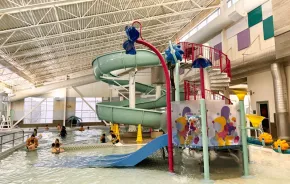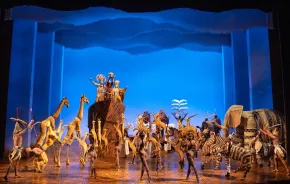Competition for the fun of it
Many young kids tend to be light on their feet, full of energy and in a hurry to get to wherever they're going. And over the past few years, the formerly adult-oriented world of road racing has begun to channel that natural affinity for running into races scaled down to kid-size.
High schools have always had track teams, but an increasing number of pre-teens are participating in 1K fun runs, kids' dashes and mini-triathlons. Since races are held in our region from April through December, participating isn't a strictly fair-weather pursuit, and kids (and families) will find plenty of events to choose from.
Children who run reap a number of benefits, from healthy bodies to feelings of pride and accomplishment. But the most important thing, race organizers and parents agree, is that for kids, running is simply fun.
Growing popularity
"Kids' events are exploding," says Alison Cox, former Events Services Director for USA Triathlon and current manager of the Benaroya Research Institute Triathlon at Seafair, which also includes a triathlon for kids ages 6-12. According to Cox, adult triathlons have been growing in popularity, and she sees a correlation between the participation of adults and children: Parents who run tend to pull their kids into the sport.
Carol Goodrow, a Massachussetts-based runner and editor of KidsRunning.com, says that media attention focused on children's need for exercise has encouraged race directors to produce children's events. "People are looking at physical activity as a lifestyle change over just 'winning,'" she says. "More people of all abilities and ages are participating."
The Seattle Marathon has hosted the Kids' Marathon since 2000, and the number of children involved has been growing by "leaps and bounds," says Executive Director Louise Long. The first year, 500 children took part in the first Kids' Marathon; now the numbers are in the thousands.
Big benefits to kids
"We (host the Kids' Marathon) to fight obesity, first of all," Long says. While fitness may indeed be the primary benefit, Goodrow mentions several other ways that running benefits children: the camaraderie of running with others in a race or through a running club, a sense of physical mastery, increased awareness of their bodies' nutritional needs and the pride involved in finishing a run.
Rachel Baker of West Seattle, whose children Anthony, 10, and Sophie, 8, this year will be participating in triathlons for the third summer, says her kids enjoy the competition and the sense of accomplishment. "...They like the fact that not that many kids they know did (it), so it gives them something to talk about. They wear their T-shirts like a trophy."
Anthony and Sophie became interested in triathlons after Baker and her sister began competing. "They thought it would be pretty fun to be able to swim, bike and run," she says. "It's something kids love to do." For the past two years, the siblings have participated in the kids' triathlon at Seafair, the proceeds of which benefit juvenile diabetes research at the Benaroya Research Institute at Virginia Mason. Last August, they also competed in the YMCA Lake Sammamish Triathlon & Kids Tri.
Keeping it fun
Baker says that she and her family focus more on enjoyment of the event than the time it takes for the kids to complete the race. Her children don't adhere to a training schedule. "They're pretty active as it is, riding their bikes around the block and going to the pool," she says, adding that the relatively short distances in kids' triathlons are manageable for her children without a training regimen. (Distances vary slightly, although the 25-yard swim, 1-mile bike and 1/4-mile run at the Benaroya Research Institute kids' triathlon are typical.)
Goodrow agrees with her approach. "If a child is doing a lot of sports, running a 5K should be possible without (a) rigid training schedule," she says. A 5-kilometer (3.1-mile) race is a long distance for any elementary-age child, so she stresses that parents should emphasize, as the Baker family does, "a finish and not a time."
Goodrow believes that winning should never be stressed with young children, and that parents should talk with kids of all ages about enjoyment, self-improvement and the benefits of running. While athletically gifted youngsters might be motivated by winning, they're a small percentage of the population, she adds.
Staying safe
Retaining the fun in a fun run or triathlon means avoiding injuries as well as burnout. According to the American Academy of Pediatrics (www.aap.org/healthtopics/physact.cfm), kids are at higher risk than adults for heat-induced illness. They also may not feel the need to drink enough when they exercise for longer periods. Although Western Washington has few summer days that top 90 degrees Fahrenheit, in very hot or humid weather kids should decrease the intensity of their activities and take frequent breaks. Parents should also make sure their children are drinking enough by enforcing periodic water or sports drink breaks even if their kids don't feel thirsty.
Buying lightweight, light-colored clothing that wicks sweat away from the body, and changing clothes that are saturated with sweat, will also help protect kids from heat-induced illness. Well-fitting shoes are a must, since kids' feet bear the brunt of their activities. In its general guidelines for athletic shoe fitting, the American Academy of Podiatric Medicine (www.aapsm.org) recommends buying shoes specifically for running at a reputable specialty shoe store and measuring the foot before every purchase. Select socks that wick moisture away from the foot and wear those socks during the fitting. Shoes should be checked frequently for wear, and runners should avoid wearing new shoes to a race.
On the nutritional front, a healthful diet will give kids the energy they need to complete races. High-fiber whole grains, plenty of colorful fruits and vegetables and low-fat dairy and protein are the building blocks for kids' health and performance
Goodrow suggests on her Web site that runners warm up and stretch before running, then stretch again after their run, and cross-train by doing another sport such as bike-riding. Kids will also benefit from learning "body smarts." Instead of running through pain, kids should be taught to allow small injuries to heal so they don't become big problems.
Children also need to learn how to pace themselves, she advises. "If a child... doesn't realize that it is OK to take walking breaks, then (a race) has the potential to be a very negative experience," Goodrow says.
Making the running experience fun and injury-free will go a long way toward the ultimate goal: encouraging kids to enjoy physical activity well into their adult lives.
Race Roundup
For current kid-friendly races, check one of the online calendars listed below.
Running Resources
- www.KidsRunning.com Extensive information about kids' running (including tips for kids with special needs). Topics include nutrition, cross-training, choosing shoes, starting a school running club, keeping kids motivated and more, presented in an easy-to-digest, ad-free format aimed at children and adults.
- www.justrun.org Youth-oriented running site; contains basic, easy-to-read information about health, nutrition, safety, getting started and warm-up drills.
- www.ontherun.com Searchable database of running events.
- www.transitiontimes.com Walk/run calendar.
- www.trifind.net Lists triathlons in Washington; kid-friendly events are easy to spot.
- www.eastsiderunners.com This club, designed for runners on the east side of Lake Washington, welcomes participants of all ages and ablities.











